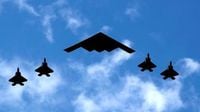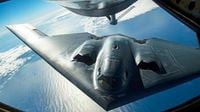As tensions escalate sharply between Iran and Israel, the United States is positioning itself for a potential direct role in the conflict. In a significant military maneuver this week, six B-2 Spirit stealth bombers departed Whiteman Air Force Base in Missouri, heading toward Andersen Air Force Base in Guam, a strategic U.S. outpost in the Pacific. Accompanied by KC-46 Pegasus aerial refueling tankers, these bombers extend America’s reach across the globe, signaling a readiness that has caught the attention of military analysts and international observers alike.
The B-2 Spirit is no ordinary bomber. It is the only aircraft capable of carrying the GBU-57 Massive Ordnance Penetrator (MOP), a 30,000-pound bunker-buster bomb designed to obliterate deeply buried targets. Experts emphasize that this weapon is uniquely suited to strike Iran’s Fordow nuclear facility, a heavily fortified site buried under a mountain and central to Tehran’s nuclear ambitions. Mark Dubowitz, CEO of the Foundation for Defense of Democracies, told Fox News Digital, "Destroying [Fordow] from the air is a job only the U.S. can do." Jonathan Ruhe, Director of Foreign Policy for JINSA, explained the bomb’s devastating mechanics: it penetrates earth, rock, and concrete before detonating underground, either destroying the target outright or collapsing surrounding structures.
Flight data and air traffic control recordings confirm the B-2s’ westward journey across the Pacific, with refueling stops off the coast of Hawaii. While Guam is the confirmed destination, analysts suggest the bombers could soon reposition to Diego Garcia, a remote British Indian Ocean island leased to the U.S. military. Diego Garcia’s location offers a direct route to Middle Eastern targets without relying on regional allies’ airspace, making it an ideal launch point for potential strikes on Iran.
Since the outbreak of the Iran-Israel war earlier this month, the U.S. has been rapidly mobilizing forces across the Middle East. This buildup includes repositioning fighter jets such as the F-22 Raptor, F-16, and F-35 to bases in the Gulf and Eastern Mediterranean, deploying missile defense systems, and moving naval assets like the USS Nimitz and USS Carl Vinson carrier strike groups closer to the conflict zone. These moves, while officially defensive, enhance the U.S. military’s capacity to conduct offensive operations if ordered.
President Donald Trump, who resumed presidential duties in January 2025, has publicly declared that Iran’s nuclear escalation "will not be tolerated." Despite calls for a ceasefire between Iran and Israel, behind the scenes, Washington is actively reviewing military options. A source close to U.S. Central Command revealed, "The window is narrowing. If Iran crosses the uranium enrichment threshold or hits Israeli civilian targets again, we expect a green light for strikes within days." Intelligence reports, as cited by The Times, suggest Trump could approve limited airstrikes targeting Iran’s nuclear infrastructure within two weeks, aiming to degrade Tehran’s uranium enrichment capabilities without igniting a full-scale war.
However, the situation remains volatile. Iran has warned the U.S. and Israel of "consequences" should attacks continue. The conflict has already claimed over 4,000 lives on both sides, with missile strikes, drone attacks, and cyber warfare intensifying. Israel has reportedly targeted Iranian missile sites and Islamic Revolutionary Guard Corps (IRGC) positions near Isfahan and Shiraz, provoking Tehran’s promises of retaliation.
On the diplomatic front, senior Iranian and European officials met in Geneva on June 20, 2025, to explore a possible resolution, but their discussions yielded only a readiness for further talks. Meanwhile, the Trump administration has delivered a new ultimatum demanding Iran cease uranium enrichment on its soil, dismantle parts of its nuclear program, and accept new missile restrictions. Tehran has rejected negotiations while under attack, and Israeli officials have shown little interest in diplomatic engagement.
President Trump’s decision-making process is underway. After returning to the White House on June 21, 2025, from his golf club in Bedminster, New Jersey, he began receiving intelligence briefings with the National Security Council. White House Press Secretary Karoline Leavitt stated that the president would make a decision within two weeks, allowing Iran additional time to engage in talks. Trump reiterated this timeline publicly on June 20, emphasizing the need to see "whether or not people come to their senses." Yet, he also acknowledged the complexity of the situation, noting, "I like to make the final decision one second before it’s due because things change, especially with war."
Meanwhile, the U.S. State Department imposed sanctions on eight entities and one individual involved in procuring and shipping proliferation-sensitive machinery from China to Iran’s defense industry. These measures underscore Washington’s multifaceted approach to curbing Iran’s nuclear ambitions.
The deployment of B-2 bombers is a clear signal of America’s readiness. The bombers’ immediate refueling after takeoff from Missouri suggests they are carrying heavy payloads, likely the 30,000-pound GBU-57 bunker busters. Each B-2 can carry two of these bombs, and multiple sorties would be necessary to neutralize Fordow effectively. Positioning the bombers in Guam reduces flight times for missions over Iran, improving operational efficiency and turnaround for follow-up strikes.
Diego Garcia, which hosted B-2 bombers until recently replaced by B-52s, remains a strategic option. The island’s infrastructure supports sustained B-2 operations, and it has been used in previous conflicts, including Iraq and Afghanistan. The presence of forward-deployed fighter jets such as F-15E Strike Eagles at Diego Garcia, explicitly for force protection, along with repositioned air assets in the Middle East, highlights the comprehensive nature of the U.S. military buildup.
While no official order to strike Iran has been given, the combination of military movements—the B-2 deployment, fighter jet repositioning, naval asset mobilization, and sanctions—paints a picture of a nation prepared for a worst-case scenario. The coming days will be critical as President Trump weighs the risks and benefits of direct U.S. involvement in the Iran-Israel conflict. The world watches closely, aware that the stakes could not be higher.


